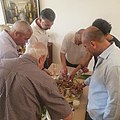Mansaf: Difference between revisions
CSV import |
CSV import |
||
| Line 24: | Line 24: | ||
{{Middle Eastern cuisine}} | {{Middle Eastern cuisine}} | ||
{{food-stub}} | {{food-stub}} | ||
<gallery> | |||
File:Mansaf,_the_traditional_dish_of_Jordan.jpg|Mansaf, the traditional dish of Jordan | |||
File:Jameed.JPG|Jameed | |||
File:Préparation_du_mansaf-Jordanie_(6).jpg|Preparation of Mansaf in Jordan | |||
File:Préparation_du_mansaf-Jordanie_(8).jpg|Preparation of Mansaf in Jordan | |||
File:Family_mansaf.jpg|Family Mansaf | |||
</gallery> | |||
Latest revision as of 04:38, 18 February 2025
Mansaf is a traditional Jordanian dish that is considered the national dish of Jordan. It is a symbol of Jordanian hospitality and is often served on special occasions and gatherings.
History[edit]
The origins of Mansaf can be traced back to the Bedouin tribes of Jordan. The dish was traditionally cooked in a large pot over an open fire, and it was often served to guests as a sign of respect and hospitality. The name "Mansaf" comes from the Arabic word for "explosion," which refers to the way the dish is traditionally served - in a large, heaping pile that "explodes" onto the plate.
Ingredients[edit]
Mansaf is made from lamb, yogurt, and rice, with the yogurt often fermented to create a product known as jameed. The lamb is cooked in the jameed until it is tender, and the rice is cooked separately. The dish is then assembled by layering the rice, lamb, and jameed in a large serving dish. It is often garnished with almonds and pine nuts, and served with flatbread.
Cultural Significance[edit]
Mansaf holds a significant place in Jordanian culture. It is often served at weddings, funerals, and other important social events. The dish is also commonly served to honor guests and show hospitality. The act of eating Mansaf is often a communal activity, with people gathering around the dish and eating with their hands.
Variations[edit]
While the traditional Mansaf is made with lamb, variations of the dish can be found throughout Jordan and other parts of the Middle East. Some versions use chicken or beef instead of lamb, and some include additional ingredients like chickpeas or vegetables. Despite these variations, the core elements of Mansaf - meat, yogurt, and rice - remain the same.
See Also[edit]
| Jordanian cuisine | ||||||||||
|---|---|---|---|---|---|---|---|---|---|---|
This Jordanian cuisine related article is a stub.
|
| Middle Eastern cuisine | ||||||||
|---|---|---|---|---|---|---|---|---|
|
-
Mansaf, the traditional dish of Jordan
-
Jameed
-
Preparation of Mansaf in Jordan
-
Preparation of Mansaf in Jordan
-
Family Mansaf





